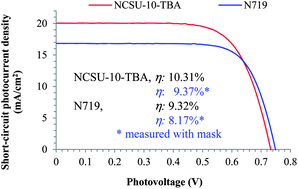Two novel high molar extinction coefficient heteroleptic Ru(II) isomers, NCSU-10 and NCSU-10′, based on carbazole antenna were synthesized with the aid of Knoevenagel reaction, to study the influence of the carbazole antenna and anchoring group (COOH) isomerization on the light harvesting efficiency (LHE), ground and excited state oxidation potentials, incident-photon-to-current conversion efficiency (IPCE), short-circuit photocurrent density (JSC), and total solar-to-electric conversion efficiency (η) for DSSCs, and their device performances were compared to the benchmark dye N719. The photophysical and photoelectrochemical properties discussed herein addressed the significant impact of the carbazole antenna and the position of the anchoring group on JSC and η in DSSCs. Tetrabutylammonium (TBA) substituted NCSU-10 achieved efficient sensitization of nanocrystalline TiO2 over the whole visible range, extending into the near IR region (ca. 870 nm) with an excellent power conversion efficiency (η) of 9.37% under an irradiation of full sunlight (100 mW cm−2) with mask compared to 8.17% of N719 under optimized conditions. NCSU-10 outperformed N719 by 45% in molar absorptivity, 18.8% in JSC, and 14.6% in the total conversion efficiency. Molecular modeling studies (DFT/TD-DFT) of NCSU-10 and NCSU-10′ showed that the HOMO is delocalized not only on Ru and NCS but also on the carbazole with a large coefficient, indicating that the second charge generation transfer in the visible region at ∼400 nm is a mixture of metal-to-ligand charge transfer (MLCT) and strong ligand–ligand charge transfer (LLCT) with a significant HOMO coefficient originating from the carbazole antenna (π) to the bipyridyl electron acceptor (π*). Moreover, DFT calculations showed that the 4,4′-isomer (NCSU-10) is a significantly stronger electron acceptor than the 5,5′-isomer (NCSU-10′), which explained the inferior electron injection and significantly lower JSC of the 5,5′-isomer.

